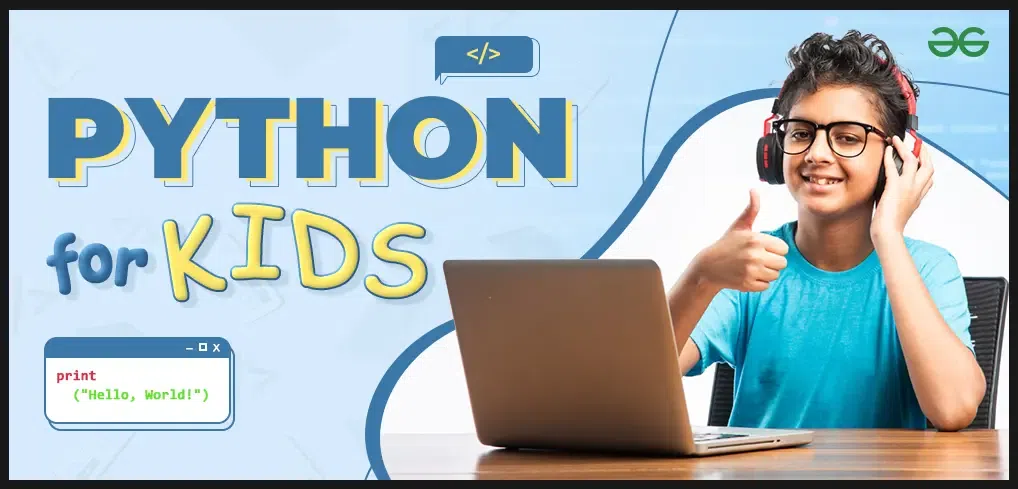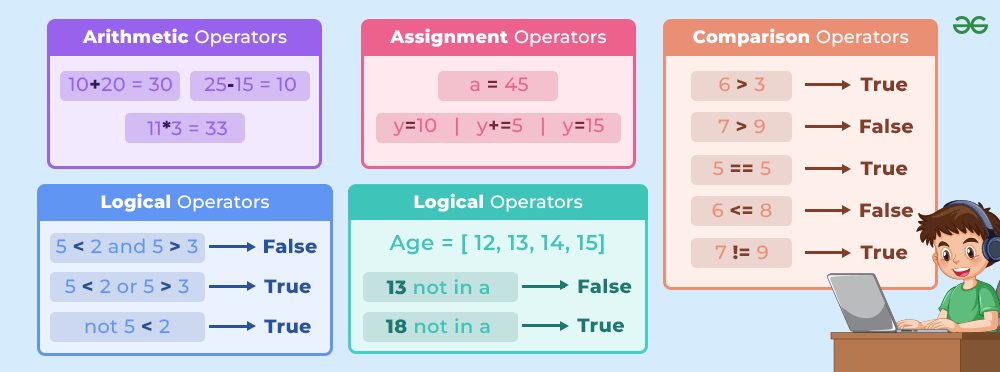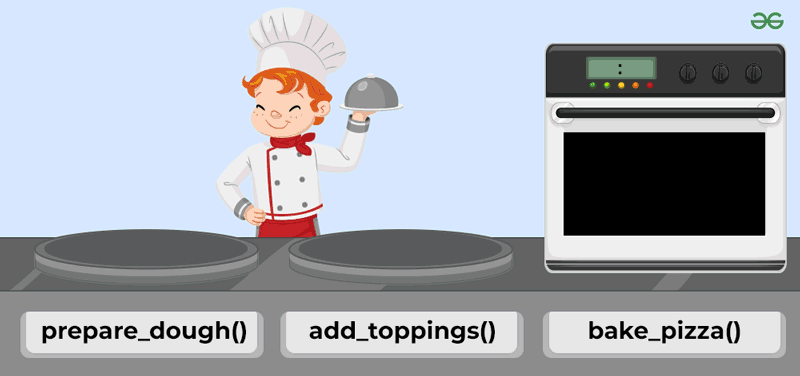
|
|
Python for Kids – Python is an easy-to-understand and good-to-start programming language. In this Python tutorial for kids or beginners, you will learn Python and know why it is a perfect fit for kids to start. Whether the child is interested in building simple games, creating art, or solving puzzles, Python provides the foundation to the kids or any beginner for their coding journey.  Python for Kids Programming is an essential skill in today’s world because programming is used everywhere in our surroundings. And to learn programming, we have to learn a programming language and Python is the best to start with programming language. It has a simple syntax and readability is the best choice for kids to understand programming concepts. In this Python tutorial, you’ll learn all the basic concepts, installation processes, and fundamental programming concepts. Table of Content – Python for Kids
What is Python?Python is a most popular, high-level (a language that is understandable for humans) language, created by Guido van Rossum and released in 1991. It is interpreted programming language (a language that directly converts human-written code into machine code) that focuses on code readability. It is famous among programmers for its clear and simple syntax, which makes it easy to read and understand. Before going directly into coding, it’s important to learn some basic concepts such as Python uses variables to store data, and it provides various data types, such as numbers, strings, and lists, and, control flow structures like conditional statements and loops, which allows for decision-making and repetitive tasks. Why Python for Kids?The main reason for a kid or a beginner to start with Python is the simplicity and versatility of Python. It makes it an ideal language for kids to start their coding journey. Here are some reasons why Python is a great choice for new learners: 
Getting Started with PythonTo begin coding in Python, you need to set up your development environment. The environment is nothing but an area where you code and write programs with interactive and several tools which made the programming easier and more interactive.
Alright!!!! As you have understood what is Python, why it is important for kids, installation, etc. – now it’s the right time to learn Python in a most easy, engaging, and creative manner. Python SyntaxPython syntax refers to the set of rules and conventions that dictate how Python code should be written in order for it to be interpreted correctly by the Python interpreter. It defines the structure and formatting of Python programs. Python code is written as a sequence of statements. Each statement represents an action or a command. For example, assigning a value to a variable, calling a function, or defining a loop are all examples of statements. Moreover, Python uses indentation to define code blocks. Unlike other programming languages that use braces or keywords, Python uses indentation to indicate the start and end of blocks of code. Typically, four spaces or a tab is used for indentation. First Python Program – Hello, World!
The “Hello, World!” program is a common starting point for beginners in any programming language. It simply displays the text “Hello, World!” on the screen. In Python, you can achieve this with just one line of code. 
Here’s how you can print “Hello, World!” in Python: Python
Output
Hello, World! Python VariablesIf we have to store something in our real life we need a container or box to store this so, the variables are nothing but simple containers to store data of different types like numbers, strings, boolean, chars, lists, tuples, ranges, etc. Python
Output
toys 10 Hello, World! Rules for Python Variables:Here are some of the rules mentioned that you must consider before naming a Python variable:
Python DatatypesData types in Python are like different kinds of boxes that can store different types of things If you have different types of toys or different types of books, Python has different types of data that it can work with. 
1. Integer (int):An integer represents whole numbers without decimals. It is like a whole cookie and represents a complete number without any pieces or fractions.
Python
Output
10
2. Float (float):A float represents numbers with decimal points, It is like a cookie that has some pieces missing. It represents a number with a decimal or fraction. It can be used to represent measurements.
Python
Output
5.5
3. String (str):A string represents a sequence of characters or alphabets. It can be used to store text-based information. The string is like a collection of letters, words, or sentences.
Python
Output
Rahul
4. Boolean (bool):A boolean represents two possible values: True or False. It deals with only true or false. A boolean is like a switch that can be either on or off. It represents a true or false value, like answering a yes or no question.
Python
Output
True
5. List:A list is an ordered collection of items. It can be used to store multiple values of different data types. A list is like a collection of items in a basket. It can contain different things, such as numbers, words, or even other lists.
Python
Output
['apple', 'banana', 'orange'] Let’s understand the List data type with one more example:
Python
Output
['red', 'blue', 'green'] You can easily add or remove colors from your list whenever you want. Lists are like a collection of items that you can change or update easily, just like your list of favorite colors.
6. Tuple:A tuple is similar to a list but is immutable, meaning its elements cannot be changed once defined. It is like a fixed sequence of items. Once it’s set, the items cannot be changed. It’s like having a locked box with things inside.
Python
Output
(3, 4) Let’s understand Tuple with one more example:
Python
Output
('Sunday', 'Monday', 'Tuesday')
7. Dictionary:A dictionary is an unordered collection of key-value pairs. It is useful for storing and retrieving data using specific keys. A dictionary is like a book with definitions. It has words (keys) and their meanings (values). Each word has a unique meaning.
Python
Output
{'country': 'USA', 'age': 12, 'name': 'Bob'}
Let’s understand Dictionary in Python with one more example:
In this dictionary, you can look up an animal’s name and find its corresponding fun fact. Python
Output
{'lion': 'Lions are known as the kings of the jungle', 'elephant': 'Elephants have a great memory'}
8. Set:A set is an unordered collection of unique elements. It is a data type that allows storing multiple values but automatically eliminates duplicates.
Python3
Output:{"apple", "banana", "orange"}
{"apple", "banana", "orange", "grapes"}
{"apple", "banana", "orange", "grapes"}
{"banana", "orange", "grapes"}
true
3
Python OperatorsOperators are unique symbols that are used to perform calculations on numbers and other information. They help us add numbers together, compare values, or change the variables’ values. Python divides the operators into the following groups:

Python Control FlowIn programming, control flow refers to the order in which the code is executed. It determines how the computer goes through different parts of the code based on certain conditions. There are two types of control flow: Conditional Statements:Conditional statements allow the computer to make decisions based on conditions. It checks if a certain condition is true or false and executes different blocks of code accordingly. Python3
Output
Sorry, you need to be older to join.
Loops:Loops allow the computer to repeat a block of code multiple times.
1. For loop:It is used to repeat a block of code a specific number of times or over a collection of items. Example: Python
Output
Hello! Hello! Hello! Hello! Hello! 2. While Loop:A while loop is used to repeat a block of code as long as a certain condition is true. Example: Python
Output
Hello! Hello! Hello! Hello! Hello!
Functions and Modules in PythonFunctions and Modules provide us with reusability and organization of code. Let’s understand in an easy manner: Function in PythonA function is a block of code that performs a specific task.
Python
Output
Preparing the dough... Adding toppings... Baking the pizza... By creating functions for each step, you can easily follow the recipe and reuse those functions whenever you want to make another pizza.
Modules in PythonModules are files containing Python code that can be imported into other programs.
OOPs in PythonOOPs is a concept that is used in industry to reusability and security of the code. In the beginning, you can skip this concept If you are a kid, but If you are interested in learning deep with Python then you are good to go.
Components in OOPSClass:A class is like a blueprint or a template that defines the characteristics (attributes) and behaviors (methods) of an object.
Objects:An object is an instance of a class. It represents a specific entity that has its own unique set of attributes and can perform actions.
Methods:A method is a function associated with an object that defines the actions or behaviors it can perform.
OOPs Concepts in PythonOOP is an important concept in Python that makes programming more fun and efficient, just like playing with building blocks. Here are some simplified explanations of Python’s Object-Oriented Programming (OOP) concepts for kids, along with real-world examples: Inheritance:Inheritance is like passing down traits from parents to children. Just like you inherit traits from your parents, objects can inherit traits and behaviors from other objects. For example, think of a superhero. They may have special powers like flying or super strength. Now, imagine a new superhero is created. They can inherit those special powers from the existing superheroes and have their own unique powers too. In programming, we can create new objects that inherit properties and behaviors from existing objects, allowing us to reuse and extend what already exists. Encapsulation:Imagine you have a treasure box. It keeps your precious things safe and hidden. Encapsulation in programming is like that treasure box. It helps us keep related things together, just like you keep your toys in a box. We put data (like attributes) and actions (like methods) inside an object, and the object keeps them safe. This way, we can control how they are accessed and make sure they are used correctly. Polymorphism:Polymorphism is like having a magic wand that can turn into different things when you need it. In programming, it means that objects can take on different forms and do different things based on the situation. For example, think of a pet. A pet can be a dog, a cat, or a bird. They all have different sounds and behaviors, but we can treat them all as “pets” and play with them. Similarly, in programming, we can have different objects that share a common behavior or interface, but they can behave differently when needed. Data Abstraction:Abstraction is like having a remote control to operate a complicated machine. Instead of worrying about the inner workings of the machine, you can use the remote to control it easily. In programming, abstraction helps us hide unnecessary details and focus on what’s important. We can create simplified interfaces that allow us to interact with objects without worrying about how they work internally. For example, think of a music player. You don’t need to understand how it plays music; you just need to press the play button to enjoy your favorite songs. These concepts of OOP help us organize, simplify, and make our programs more flexible. Encapsulation keeps things organized and safe, polymorphism allows objects to behave differently when needed, inheritance helps us reuse and extend existing code, and abstraction lets us focus on what’s important without worrying about the details. Together, they make programming more fun and efficient, just like using your imagination to create new things and play with them. Python Projects for KidsTo make learning Python more exciting, here are a few project ideas for kids:
ConclusionPython is an excellent programming language for kids due to its simplicity and versatility. Its easy syntax, large community, and wide range of applications make it a perfect choice for beginners. By starting their coding journey with Python, kids can develop problem-solving skills, boost their creativity, and make a solid foundation for future programming works. FAQs Related to Python For KidsQ1. Can kids learn Python even if they have no prior programming experience?Answer:
Q2. Are there any online resources available for kids to learn Python?Answer:
Q3. What age range is Python suitable for?Answer:
Q4. Can Python be used to create professional-level projects?Answer:
|
Reffered: https://www.geeksforgeeks.org
| Python |
Type: | Geek |
Category: | Coding |
Sub Category: | Tutorial |
Uploaded by: | Admin |
Views: | 13 |


